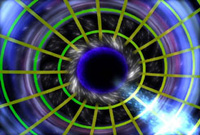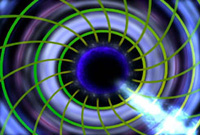|
|
Taking Black Holes for a Spin
Early in 2001, Dr. Tod Strohmeyer (NASA/GSFC) discovered evidence for
a rotating black hole. No one doubts that black holes rotate, but
evidence for them has been elusive. Through careful analysis of data
from the Rossi X-ray Timing Explorer, Dr. Strohmeyer found such
evidence by examining how fast surrounding gas orbited the black hole.
The videos presented here illustrate this property of a rotating
black hole.
Black Hole in Binary Star System

Click on the image to view the video.
(6 Mb QuickTime)
(Credit: NASA/Honeywell Max-Q Digital Group/Dana Berry)
(Description)
|
In this video we see a black hole in a binary star system, with
material from the blue giant star streaming towards the black hole.
The gas in this stream orbits the black hole and forms a
disk. Gas orbiting closer to the black hole moves faster than
gas farther out. The gas heats up due to interaction of
material moving at these different speeds, becoming hot enough
to emit x-rays. Lines from the poles of the
black hole represent jets of gas being ejected from the vicinity of
the black hole at nearly the speed of light. How these jets form is
poorly understood, but they are often seen near black holes accreting
large amounts of material.
The gap between the gas disk and the black
hole (seen near the end of the video) represents the innermost orbit
matter can be in before
plunging into the black hole. The radius of this innermost orbit
depends on whether the black hole is
rotating or not. If the black hole is rotating, material can orbit
in more closely, causing the material to move faster than if the black
hole is not rotating.
|
Space-time Near a Rotating Black Hole
 |

|
Click on either image to view the video. (6
Mb QuickTime)
(Credit: NASA/Honeywell Max-Q Digital Group/Dana Berry)
(Description)
|
This video illustrates the difference between a spinning and
non-spinning black hole. In each, lines of space-time are drawn around the
event horizon. In the video, the event horizon is surrounded by a blue glow,
which represents gas just before if falls past the event horizon.
The innermost stable orbit is the ring of gas outside this blue glow.
You can see that space-time is curved around the black hole which is
rotating. As a consequence, around a rotating black hole the gas can
be in a closer orbit.
|
